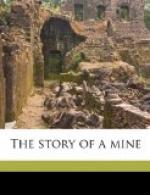Thoroughly appreciating the taste and comfort of Harlowe’s library, yet half-envious of its owner, and half-suspicious that his own earnest life for the past few years might have been different, Thatcher suddenly started from his seat and walked towards a parlor easel, whereon stood a picture. It was Carmen de Haro’s first sketch of the furnace and the mine.
“I see you are taken with that picture,” said Harlowe, pausing with the champagne bottle in his hand. “You show your good taste. It’s been much admired. Observe how splendidly that firelight plays over the sleeping face of that figure, yet brings out by very contrast its almost death-like repose. Those rocks are powerfully handled; what a suggestion of mystery in those shadows! You know the painter?”
Thatcher murmured, “Miss De Haro,” with a new and rather odd self-consciousness in speaking her name.
“Yes. And you know the story of the picture of course?”
Thatcher thought he didn’t. Well, no; in fact, he did not remember.
“Why, this recumbent figure was an old Spanish lover of hers, whom she believed to have been murdered there. It’s a ghastly fancy, isn’t it?”
Two things annoyed Thatcher: first the epithet “lover,” as applied to Concho by another man; second, that the picture belonged to him: and what the d—–l did she mean by—
“Yes,” he broke out finally, “but how did you get it?”
“Oh, I bought it of her. I’ve been a sort of patron of her ever since I found out how she stood towards us. As she was quite alone here in Washington, my mother and sister have taken her up, and have been doing the social thing.”
“How long since?” asked Thatcher.
“Oh, not long. The day she telegraphed you, she came here to know what she could do for us, and when I said nothing could be done except to keep Congress off, why, she went and did it. For she, and she alone, got that speech out of the Senator. But,” he added, a little mischievously, “you seem to know very little about her?”
“No!—I—that is—I’ve been very busy lately,” returned Thatcher, staring at the picture. “Does she come here often?”
“Yes, lately, quite often; she was here this evening with mother; was here, I think, when you came.”
Thatcher looked intently at Harlowe. But that gentleman’s face betrayed no confusion. Thatcher refilled his glass a little awkwardly, tossed off the liquor at a draught, and rose to his feet.
“Come, old fellow, you’re not going now. I shan’t permit it,” said Harlowe, laying his hand kindly on his client’s shoulder. “You’re out of sorts! Stay here with me to-night. Our accommodations are not large, but are elastic. I can bestow you comfortably until morning. Wait here a moment while I give the necessary orders.”
Thatcher was not sorry to be left alone. In the last half hour he had become convinced that his love for Carmen de Haro had been in some way most dreadfully abused. While he was hard at work in California, she was being introduced in Washington society by parties with eligible brothers who bought her paintings. It is a relief to the truly jealous mind to indulge in plurals. Thatcher liked to think that she was already beset by hundreds of brothers.




